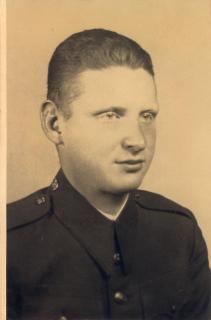Werner Meissner Part I: Experiences in Europe until 1936

Werner Meissner has written the story of his life and gave me a copy when I visited with him in Haifa only a month ago.
It begins like this:
"Like so many Jewish families which survived the war, which means from the year 1945, all three generations which exist in our family were born on a different continent. This stands in big contradiction to Jewish tradition until the Second World War that families often lived and worked for many centuries in the same place, in the same kehilah.
We, Perla [his wife] and I were born in Europe, in [what was then] Czechoslovakia; Judith and Ronit were born in tropical El Salvador and our grandchildren are citizens of Jerusalem which we desired for so longingly in all prayers and which is today the capital of the free Jewish state."
Werner's story begins in Trisch, a town near Moravia. As delineated in his memoir, the Jewish community of Trisch dates back to the 15th century. He was one of four sons, Kurt (born in 1913), Werner (born in 1914), Berthold (born in 1917), and Erich (born in 1922). The older three were born in Trisch while Erich was born in Bilitz, the town where the Meissners eventually settled.
Today only Erich and Werner remain. Berthold died from dysentery as a young child while Kurt was murdered at Auschwitz.
Before the war, the Meissner family had a very full life with religion structuring many of their activities. Werner remembers: "My parent's house was a traditional Jewish home. Family, respect for the parents, education, self-respect, fulfilling duties were all goals of our education..... In the house, we always kept our own traditions for example, we did not drive on the Sabbath. Furthermore, Dad did not smoke on this day, but went to work by foot. Usually he drove to work. We did not write in the school [on Shabbat] until the last school year. On Saturdays, we had training on the sports ground. We went by foot but we did train. We kept all the holidays, of course and since I was singing in the temple's choir, I got there punctually every Friday evening and Saturday. In the winter, when it got dark early, the Sabbath entered already at 4 o'clock. Even so, Dad came home from work later and would recite the whole evening prayer before the meal. We had a very nice temple with a very nice service. The atmosphere on the holidays in the house is part of my youth's memories."
At age 14, Werner joined the Hasmoneans, a Zionist High School Union. Set-up like a youth group, the members learned Jewish history, Zionist philosophy, played sports and took trips.
Werner writes, "The whole Union was secret of course. The school should not know. Therefore it became even more interesting."
After high school, Werner decided to learn more about Bilitz's textile industry. After a year apprenticeship, Werner applied for a graduate course to continue his study of textiles. In 1934, he began his studies in Bruenn. Werner lived with a roommate in a boarding house and visited his brother Kurt in medical school (also in Bruenn) on the weekends. That same year, Werner was summoned for military service by the Czech consulate. During the medical examination, he was deemed unfit due to a hernia. Only one year later, Werner received a notice from the Czech military that his status was now being upgraded from "unfit" to "fit with fracture."
Werner began his military service for the Czech republic on September 1, 1936.
Photo: from Meissner family collection. Werner as a Czech soldier. Circa 1936.


0 Comments:
Post a Comment
<< Home